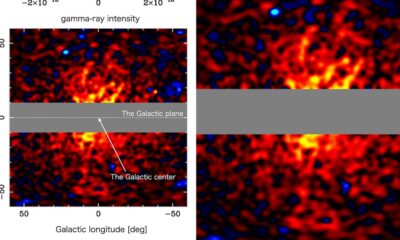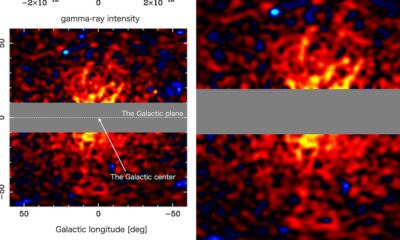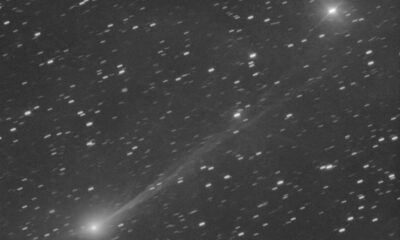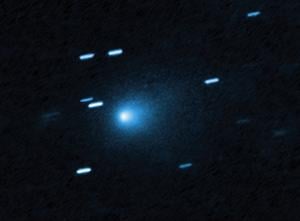Science
New Horizons Marks 10 Years Since Pluto Flyby; Future Missions Uncertain

NASA’s New Horizons spacecraft celebrated the tenth anniversary of its historic flyby of Pluto on **July 14, 2015**, providing scientists with a wealth of data about the distant dwarf planet. This mission unveiled a captivating landscape featuring a heart-shaped region of frozen nitrogen and methane, alongside towering mountains of water ice. The images captured during the brief encounter answered numerous questions about Pluto, a world that has intrigued researchers since its discovery by astronomer **Clyde Tombaugh** in **1930**. Yet, as is common in space exploration, the findings raised even more questions about the dynamic processes occurring so far from the Sun.
Currently, scientists have over **50 gigabits** of data from New Horizons to analyze, but they face a significant challenge: there are no planned missions to revisit Pluto in the foreseeable future. The prospects for a follow-up mission remain bleak, with no funding allocated for such endeavors in NASA’s budget. As the spacecraft continues its journey through the Kuiper Belt toward interstellar space, researchers are left to rely on ground-based telescopes and space observatories like the **Hubble** and **James Webb** to further investigate Pluto’s mysteries.
Challenges for Future Exploration
Under typical funding conditions, a new mission to Pluto might have been considered within the next **10 to 20 years**, following the completion of higher-priority missions such as the **Mars Sample Return** and a planned mission to orbit **Uranus**. However, the current political landscape complicates matters. The administration under **Donald Trump** proposed significant cuts to NASA’s science budget, which could jeopardize ongoing missions and future exploration opportunities. If approved, these cuts would not only affect spacecraft operations but would also eliminate funding for crucial research and analysis of existing missions’ data.
A recent report from the National Academies prioritized missions to Mars, Uranus, and **Enceladus**, leaving little room for a second exploration of Pluto. The decadal survey concluded that a follow-up mission to Pluto is not a priority and did not even warrant a technical evaluation. The scientific community has reached a consensus that an orbiter, rather than a flyby, is essential for answering pivotal questions about Pluto, such as the characteristics of its ice sheets and the status of its suspected cryovolcanoes.
The **New Horizons** mission provided only a fleeting glimpse of Pluto, approaching the dwarf planet at a velocity of nearly **31,000 mph** (14 kilometers per second) and coming within **7,750 miles** (12,500 kilometers) of its surface. This brief encounter limited the spacecraft’s ability to capture detailed images and data, resulting in a compelling yet incomplete understanding of Pluto’s geology and atmosphere.
The Persephone Mission Concept
In light of these challenges, some scientists involved in the New Horizons mission have proposed a conceptual mission, named **Persephone**, to orbit Pluto. Though not officially submitted to NASA, this mission aims to provide a comprehensive study of the dwarf planet. Initial plans called for a **2031** launch using NASA’s Space Launch System Block 2 rocket, but this timeline remains speculative given the complexities involved in reaching and capturing an orbiter around Pluto.
The proposed Persephone mission would take more than **27 years** to reach Pluto, with an expected arrival in **2058**. Another concept, led by **Alan Stern**, the principal investigator of New Horizons, envisions a spacecraft capable of leaving Pluto to explore additional celestial bodies. Both concepts indicate that a gravitational assist from **Jupiter** would be necessary, but Jupiter will not be optimally positioned for such missions until the early **2040s**, prolonging travel time significantly.
Nuclear propulsion technology is considered a potential solution for enhancing mission efficiency. The Persephone concept suggests using five nuclear radioisotope power generators, along with electric thrusters, to shorten flight time and improve data transmission capabilities. However, the development of these technologies is still in its early stages, and funding for nuclear propulsion research is currently under threat from proposed budget cuts.
As the scientific community grapples with these uncertainties, the estimated cost of a Pluto orbiter mission, such as Persephone, could reach **$3 billion**, excluding launch expenses. With the reality of funding constraints and the prioritization of other missions, it appears that a return to Pluto may take decades longer than previously hoped.
As researchers reflect on the last decade since New Horizons’ encounter, they brace for a lengthy wait before they can explore the enigmatic world of Pluto again, potentially re-evaluating their own timelines for future discoveries in the cosmos.
-

 Politics4 weeks ago
Politics4 weeks agoSecwepemc First Nation Seeks Aboriginal Title Over Kamloops Area
-

 World5 months ago
World5 months agoScientists Unearth Ancient Antarctic Ice to Unlock Climate Secrets
-

 Entertainment5 months ago
Entertainment5 months agoTrump and McCormick to Announce $70 Billion Energy Investments
-

 Science5 months ago
Science5 months agoFour Astronauts Return to Earth After International Space Station Mission
-

 Lifestyle5 months ago
Lifestyle5 months agoTransLink Launches Food Truck Program to Boost Revenue in Vancouver
-

 Technology3 months ago
Technology3 months agoApple Notes Enhances Functionality with Markdown Support in macOS 26
-

 Lifestyle3 months ago
Lifestyle3 months agoManitoba’s Burger Champion Shines Again Amid Dining Innovations
-

 Top Stories2 months ago
Top Stories2 months agoUrgent Update: Fatal Crash on Highway 99 Claims Life of Pitt Meadows Man
-

 Politics4 months ago
Politics4 months agoUkrainian Tennis Star Elina Svitolina Faces Death Threats Online
-

 Sports5 months ago
Sports5 months agoSearch Underway for Missing Hunter Amid Hokkaido Bear Emergency
-

 Politics5 months ago
Politics5 months agoCarney Engages First Nations Leaders at Development Law Summit
-

 Technology5 months ago
Technology5 months agoFrosthaven Launches Early Access on July 31, 2025





















